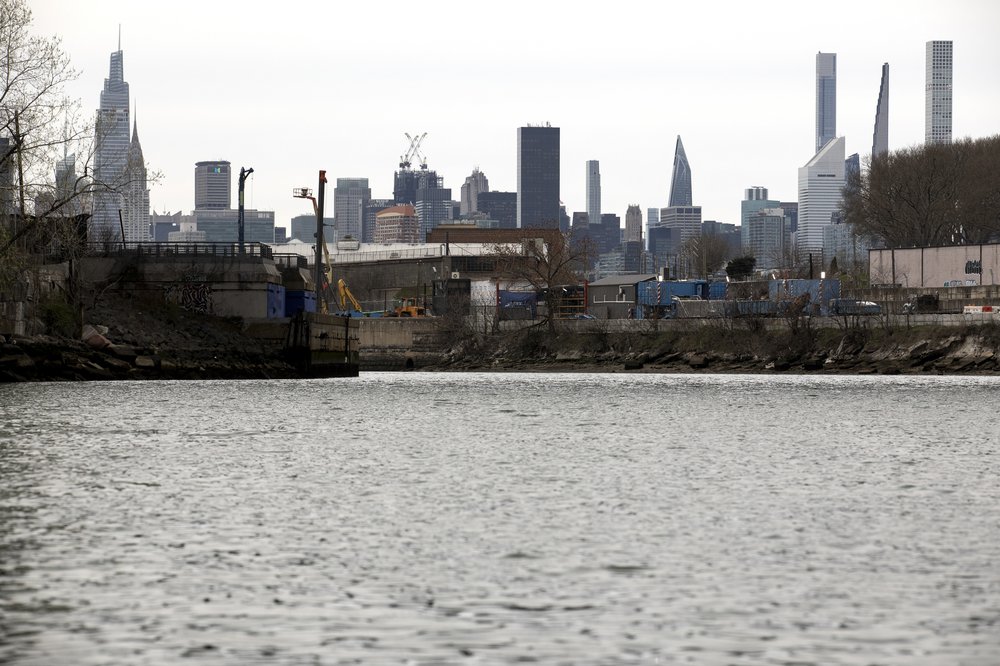NYC plans massive tunnel to keep sewage from flowing into Newtown Creek
Feb. 12, 2025, 11:07 a.m.
The city Department of Environmental Protection plans a major upgrade to the area's sewer system, which discharges sewage into the creek during rainstorms.

New York City environmental officials plan to reduce the heavy flow of sewage into Newtown Creek through the construction of a new tunnel that would serve as a major upgrade to the area’s century-old sewer infrastructure.
The 3.8 mile creek is one of the city’s worst dumping sites, due to antiquated systems that force untreated sewage to flow into the waterway from more than 20 locations during rainstorms. Every year, about a billion gallons of sewage flow into the estuary, which is a federally designated Superfund site due to its history of industrial dumping.
The city Department of Environmental Protection aims to solve the sewage problem by building a 26-foot-wide, 3.26-mile-mile tunnel to divert overflow and store up to 50 million gallons of runoff that would otherwise flow into the creek when it rains. The tunnel would allow the stored sewage to be pumped to the Newtown Creek wastewater treatment plant in Greenpoint.
Officials published an initial environmental impact statement on the project last week, laying out a lengthy approval process to build the tunnel that will also require the seizure of public and private property.
“ It costs a lot of money. It takes a lot of time, but it's absolutely necessary,” said Willis Elkins, executive director of the Newtown Creek Alliance. “ We want it to be as big and best as it can be so that we don't have untreated sewage going to our water bodies.”
Under the plan, the city would either need to acquire or gain access to 11 properties along Newtown Creek. The city sanitation department owns two of the lots, and three are owned by the Long Island Rail Road. MTA spokesperson Joana Flores said the agency is “in discussions with the NYC Department of Environmental Protection” about the project.
The remaining six sites are privately owned. Gothamist reached out to several of the owners, and some said they had no knowledge their land would be affected by the city’s plan. DEP representatives did not respond to an inquiry as to whether they have informed the property owners.
The properties required for acquisition are located near four major outfalls, which account for more than 90% of sewage that flows into the creek. The DEP plans to construct a diversion facility on those sites that would move the excess sewage into the new storage tunnel.
The DEP’s plan shows the tunnel would be located 80 to 130 feet below ground, and crews would require underground access to more than 80 additional properties along the creek, most of them privately owned industrial sites.
Environmental advocates argue the bureaucratic hurdles are a small price to pay for a cleaner waterway.
“It's a critical project,” said Mike Dulong, Riverkeeper’s legal program director. “ We are very, very supportive of this project.”
The Newtown Creek tunnel project is similar to the one currently under construction at the Gowanus Canal. They both serve the same purpose: catching sewage and stormwater when sewers reach capacity during rainstorms. Instead of discharging into the waterways, the raw sewage and polluted storm runoff from streets, roofs and other impervious surfaces would be captured, stored until the rain subsides and then pumped to the wastewater treatment plant.
“ This is a major piece of the solution because the New York City sewer system is very old, and so we are not building a new system from scratch.” Dulong said. “We are trying to fix an old system, and so this is one way to do it, which is to capture sewage and stormwater at the end of the pipe before it goes to the waterway.”
Newtown Creek is part of the Hudson River estuary, but empties into the East River.
While the creek has a surface area of only 140 acres, the surrounding area that drains into the creek encompasses 6,815 acres. Before industrialization in the early 1900s, Newtown Creek was a stream with five tributaries. By 1930, the creek was a major industrial waterway that served oil refineries and gas plants.
Nearly a century's worth of untreated sewage and industrial waste destroyed the creek’s natural marshlands and freshwater streams. The waterway is now mostly stagnant with very little movement and circulation, which causes pollutants to build up, degrading the water quality.
“It means that the water is not safe to have any contact with during or after a rain event, and it takes a very long time for the water quality to recover again because it's so stagnant,” Elkins said.
According to the local advocacy group Newtown Creek Alliance, sewage discharges into the waterway roughly 40 times per year.
“If you're discharging sewage into the East River or the Hudson, it's a much larger body of water and it's constantly moving with the tides and the currents,” Elkins said. “Whereas our water body (Newtown Creek) does not have much movement, so the impacts of dumping sewage are much more severe because of the size and the conditions.”
In 2010, the EPA designated Newtown Creek as a Superfund site because of the hazardous waste contamination. The proposed tunnel would meet some of the remediation goals outlined by the EPA.
“It's not just a good thing for the city to have clean, usable waters that we can all recreate on, but it is a requirement under the Clean Water Act,” Dulong said. “The city does not have a choice. It has to build these tunnels. These are now a requirement under a consent decree with the state.”
The DEP will hold a virtual public meeting on its draft plan on March 12 at 7 p.m., and the public can submit comments on the proposal until April 11.
EPA delays cleanup of Brooklyn’s toxic Newtown Creek Superfund site until 2032